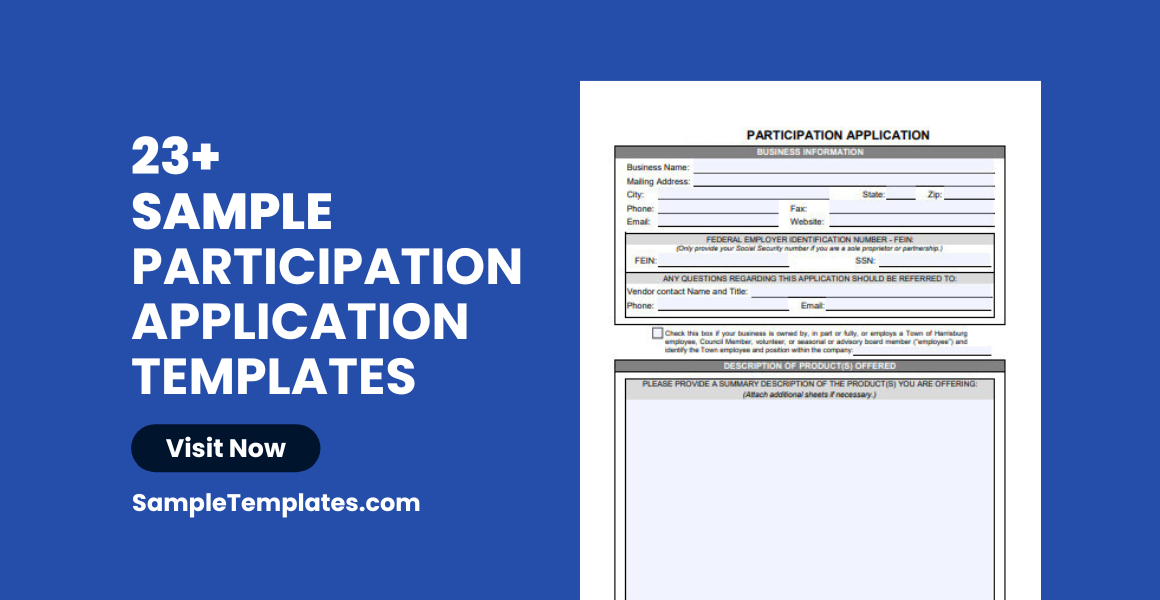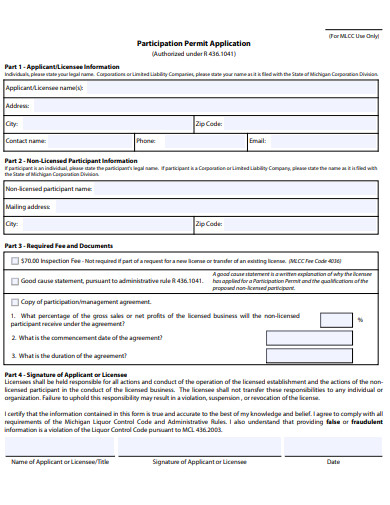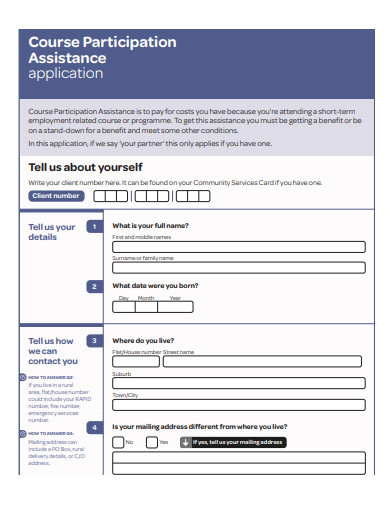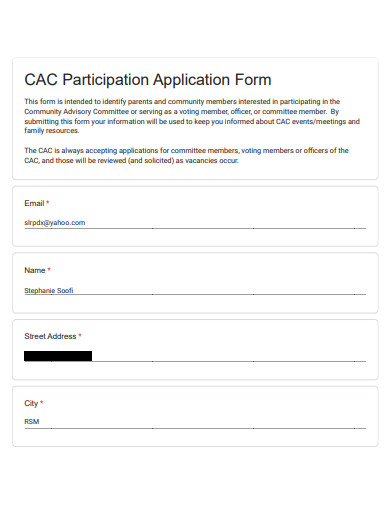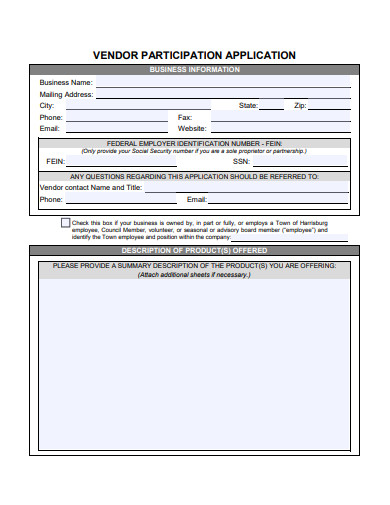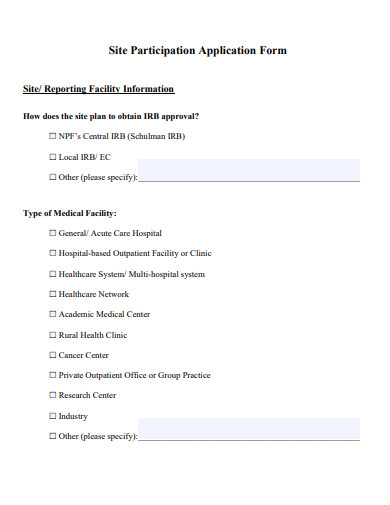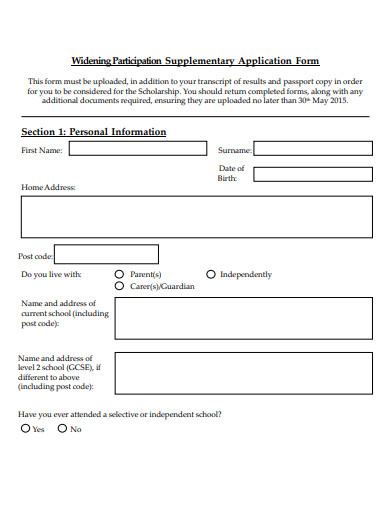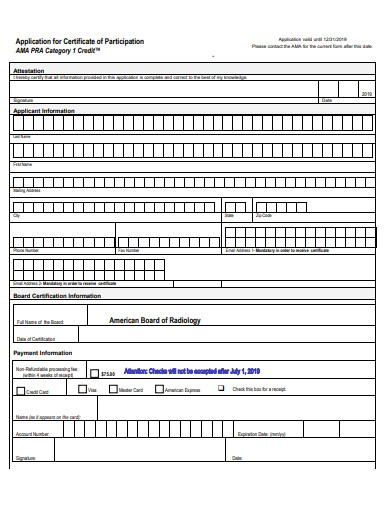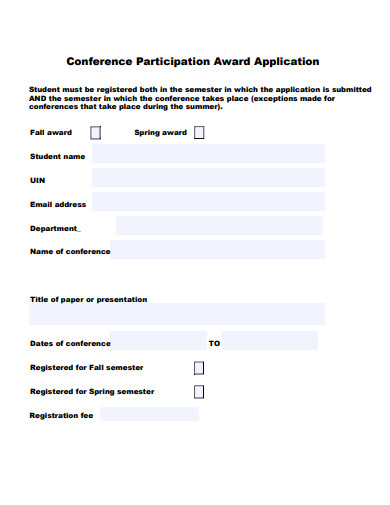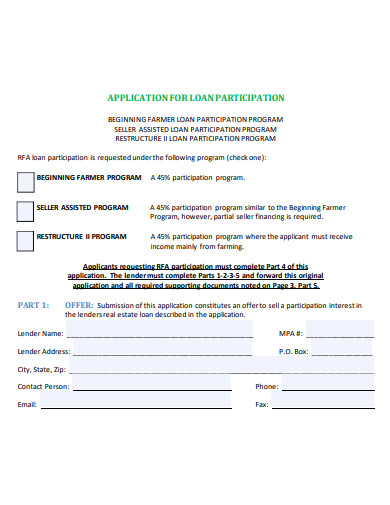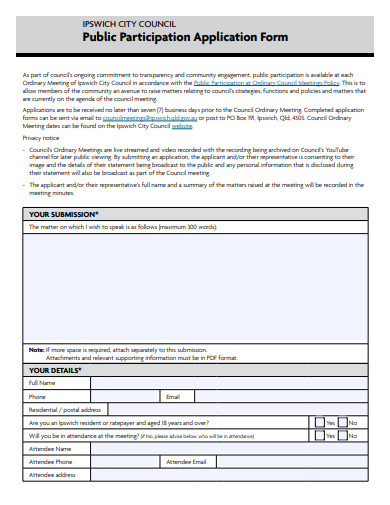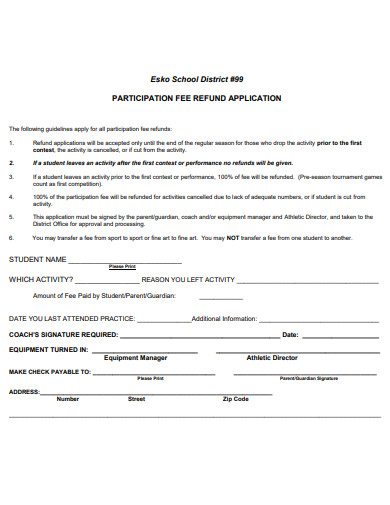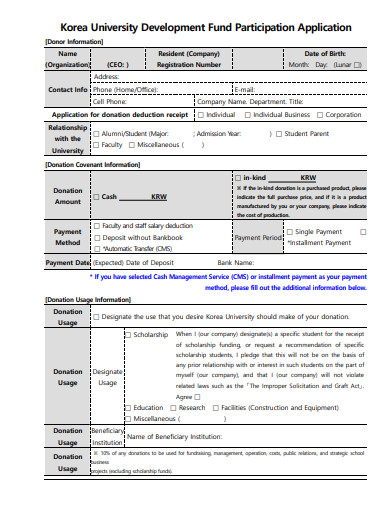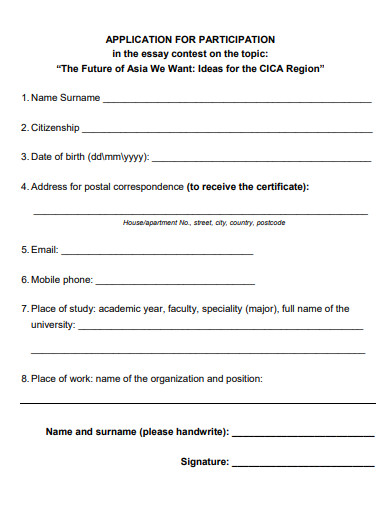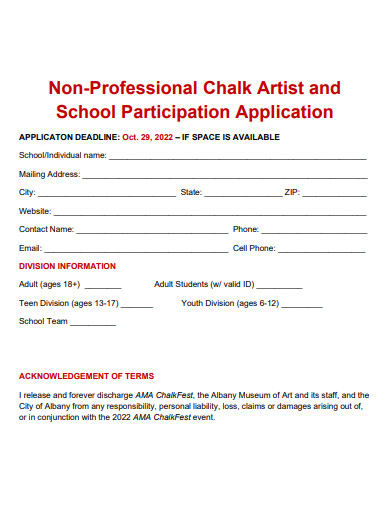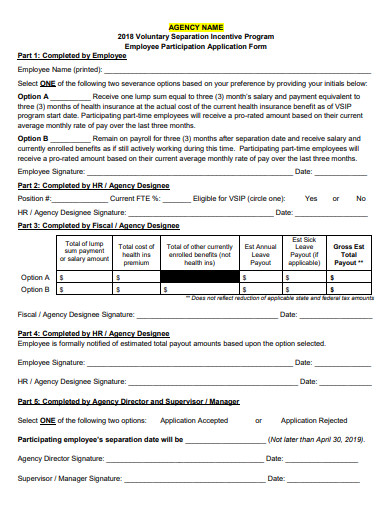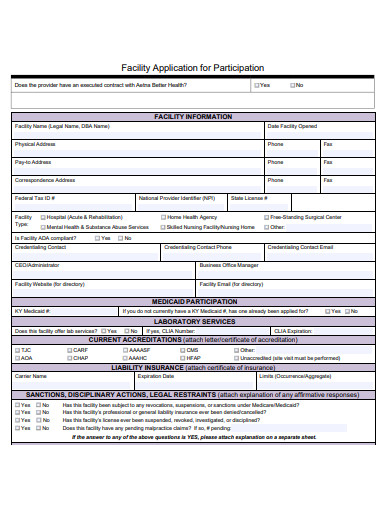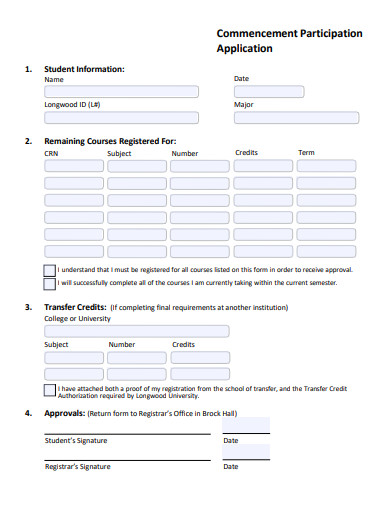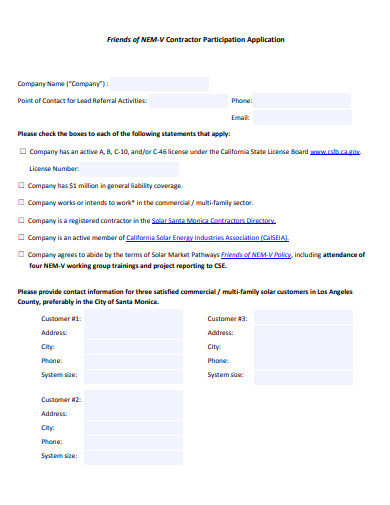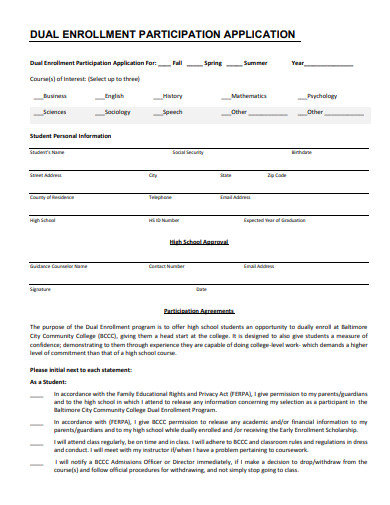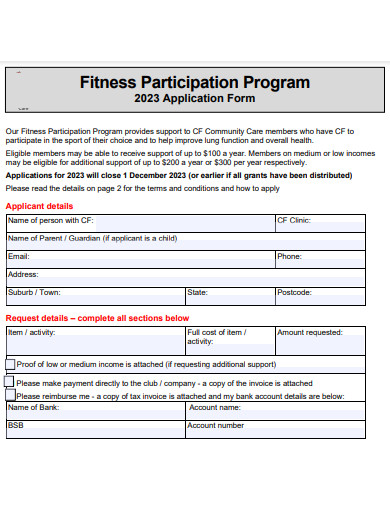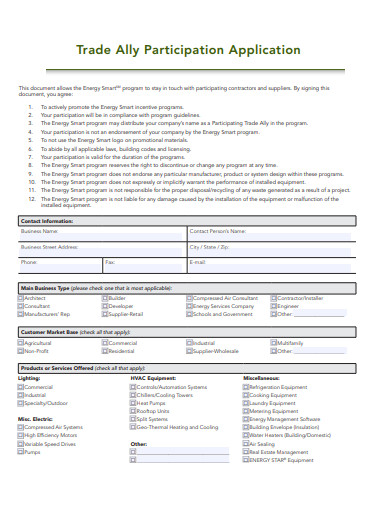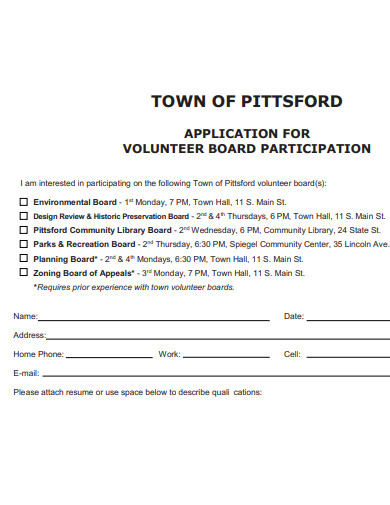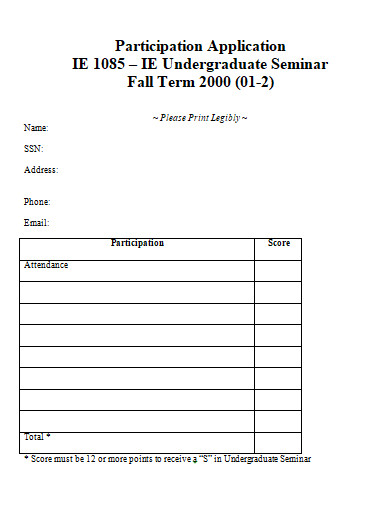In realms where involvement and engagement are sought, the ‘Participation Application’ is a fundamental tool. Designed to evaluate and enlist individuals for sample events, programs, or activities, it ensures a smooth and organized intake process. From workshops to community events, a well-structured Participation Application ensures that both organizers and participants are aligned in purpose and expectations. Explore our guide to understand its design, significance, and the role it plays in fostering enriching experiences.
23+ Participation Application Samples
1. Sample Participation Permit Application Template
2. Sample Course Participation Assistance Application Template
3. Sample Participation Application Form Template
4. Sample Vendor Participation Application Template
5. Sample Site Participation Application Form Template
6. Sample Participation Supplementary Application Form
What is Participation Application?
The term “Participation Application” can be applied in various contexts, from business and tech to social organizations. While it might not be as commonly referenced as other types of applications, its role is undeniably crucial in many sectors. Here’s a comprehensive guide on what a Participation Application is and why it matters.
A Participation Application, at its core, is a sample form or a process used by organizations or entities to gather pertinent information from individuals or entities desiring to take part in a specific activity, event, program, or system. Depending on its use-case, it might be used for enrolling members into a sample program, screening applicants for an event, or even integrating third-party developers into a software system.
Origins of the Participation Application
Historically, any form of collaboration or participation was often sealed with verbal agreement format or simple written contracts. With the rise of organized structures in business, tech, and society, the need for standardized participation processes became evident. This birthed the concept of a formal Participation Application.
Common Contexts for Participation Applications
- Events and Programs: For individuals wishing to partake in seminars, workshops, or community programs. The application helps organizers assess suitability and manage logistics.
- Business Collaborations: Companies might use it when seeking partners for joint ventures or collaborative projects.
- Tech Platforms: In the tech industry, developers wishing to integrate their services with an existing platform might be asked to fill out a Participation Application. This ensures compatibility and security.
- Membership Clubs: Clubs or organizations might use these applications to screen potential members, ensuring they align with the group’s goals and values.
Different Facets of Participation Applications
- Event-Centric Applications: These are tailored for one-time events like seminars, exhibitions, and conferences. They gather data related to attendance, accommodation needs, and often include payment processes.
- Membership Driven: Aimed at individuals or entities seeking long-term association with clubs, organizations, or business consortiums.
- Technology Platforms: Here, the application format serves tech developers aiming to integrate or collaborate with an existing digital infrastructure or platform.
- Research & Academic: Used by institutions to enroll participants for studies, sample surveys, or academic programs.
Structural Anatomy of the Application
- Identification Section: Basic details like name, address, and other contact information.
- Objective Synopsis: A brief on why the individual/entity wishes to participate.
- Credential Overview: Qualifications or prerequisites showcasing the suitability for participation.
- Previous Engagements: History of past participations or relevant experiences.
- Declaration and Consent: A space to confirm understanding and sample agreement to the associated terms.
Ensuring a Transparent Process
The importance of transparency in the application process is paramount. It not only establishes trust but also ensures clarity. Features like clear guidelines, FAQ sections, and accessible support channels can significantly enhance transparency.
Key Components of a Participation Application
- Personal or Entity Details: Name, contact details, background, and other relevant identifying information.
- Purpose for Participation: Why the applicant wishes to join or be involved.
- Qualifications: Details that help determine the applicant’s suitability for participation.
- References or Past Experiences: For added context and verification.
- Terms and Conditions: To ensure the applicant understands and agrees to the rules, guidelines, or requirements of participation.
Benefits of a Participation Application
- Screening: Ensures that participants are aligned with the sample objectives of the event, program, or platform.
- Organizational Efficiency: Helps in sample planning and logistics, ensuring smooth operations.
- Risk Management: By vetting participants, organizations can mitigate potential risks.
- Data Collection: Provides valuable data for sample feedback, analytics, and future improvements.
Challenges and Considerations
- Data Security and Privacy: Organizations must ensure the confidentiality and security of applicant data.
- Accessibility: The application process should be user-friendly and accessible to all potential participants.
- Bias and Fairness: It’s essential to ensure the application process is impartial and free from biases.
How to Fill a Participation Application?
Filling out a Participation Application might seem like a simple task, but ensuring accuracy and completeness is vital. An appropriately filled application can be the difference between acceptance and rejection in many cases. Here’s a comprehensive guide to help you navigate this process with ease.
Understanding the Purpose
Before diving into the application, it’s crucial to understand why you’re filling it out:
- Scope of Participation: Whether it’s for an event, a membership, technological integration, or any other collaborative endeavor.
- Requirements: Familiarize yourself with the qualifications or criteria set by the organizers.
Gathering Necessary Documents
Have all essential design documents at hand. This could include:
- Personal identification (like a driver’s license or passport)
- Certificates or proofs of qualifications
- Previous participation records or references
- Any other relevant process documentation
Filling Out the Application
a) Personal Details
- Ensure you write your full name as it appears on your official documents.
- Provide accurate contact details, including address, phone number, and email.
b) Objective or Purpose:
- Mention clearly and concisely why you wish to participate.
- If applicable, outline how your participation will benefit both you and the organizing entity.
c) Qualifications
- List down relevant qualifications or experiences that make you a suitable participant.
- Attach proofs or sample certificates wherever required.
d) References:
- Some applications may ask for references. Ensure you’ve informed your references in advance and provide their accurate contact details.
e) Additional Information:
- Some forms have a section for any supplementary information. Use this space to mention anything that might bolster your application, but wasn’t covered in previous sections.
Finalizing and Submitting
- Ensure all attached documents are clear and legible.
- If it’s a digital application, make sure all uploads are in the specified format and size.
- Before final submission, review the application once more. It’s easy to overlook minor details.
- If there’s a declaration or consent section, read it thoroughly before signing or agreeing.
Post-Submission
- Keep a copy of the filled application and all attached documents. This is essential for reference or in case any discrepancies arise.
- If provided, note down any reference or sample acknowledgment number related to your submission.
- Stay updated with any communication channels specified in the application, be it email or phone.
7. Sample Certificate of Participation Application Template
8. Sample Conference Participation Award Application Template
9. Sample Loan Participation Application Template
10. Sample Public Participation Application Form Template
11. Sample Participation Fee Refund Application Template
12. Sample University Development Fund Participation Application
13. Sample Participation Application Example
14. Sample School Participation Application Template
15. Sample Employee Participation Application Form Template
16. Sample Facility Participation Application Template
17. Sample Commencement Participation Application Template
18. Sample Contractor Participation Application Template
19. Sample Dual Enrollment Participation Application
20. Sample Board Participation Application Template
21. Sample Fitness Participation Program Application Form
22. Sample Trade Participation Application Template
23. Sample Volunteer Board Participation Application
24. Sample Seminar Participation Application Template
How do you Create a Participation Application?
Creating a participation application is essential for activities like workshops, events, clubs, or any group activity where there’s a need to gather details and consent from potential participants. Here’s a step-by-step guide to create:
Step 1: Define the Purpose Determine the specific activity or event for which you’re creating the application. Is it a workshop, a competition, a training program, or a membership for a club? Clearly defining the purpose helps you understand what information you’ll need to gather from the applicants.
Step 2: Design the Application Layout Choose a format that’s easy to fill out, whether it’s digital or sample paper-based. Make sure it’s clean and intuitive. Tools like Google Forms, Microsoft Forms, or even Word and PDF templates can be effective, depending on your audience and distribution method.
Step 3: Gather Personal Details Begin with basic information:
- Full Name
- Contact Information (phone number, email address)
- Date of Birth/Age (if relevant)
- Address
Step 4: Specific Event or Activity Details Depending on the nature of the participation, you might need details like:
- Skills or Qualifications: For workshops or courses, where prior knowledge might be necessary.
- Reasons for Participation: Useful to understand the participant’s motivation or to select from a large pool of applicants.
- Preferred Session/Date: If the event or activity has multiple sessions or dates.
Step 5: Obtain Consent and Acknowledgements Include sections where applicants:
- Agree to the terms and conditions of participation, which might include behavior codes, payment agreements, or data usage policies.
- Acknowledge risks, if any, associated with the activity (like physical risks in a sports event).
- Provide emergency contact details, especially if there’s any potential risk involved in the activity.
Step 6: Optional Requirements Depending on the nature of the event, you might need:
- References: Especially for long-term commitments or memberships.
- Portfolio or Previous Work: For artistic endeavors or workshops.
- Dietary or Accessibility Requirements: To ensure you cater to all needs during the event.
Step 7: Design a Submission Process Decide how applicants will submit their professional forms. Will they email it, submit via a website, or hand in a physical copy? Ensure instructions are clear, including submission deadlines.
Step 8: Review and Privacy Statement Especially if dealing with minors or sensitive data, include a privacy statement detailing how you’ll use and store the provided information. Assure applicants that their data is protected.
Step 9: Signature and Date A crucial section. Whether it’s a digital acknowledgment or a physical signature, this provides consent and agreement to everything mentioned in the application. Always include a space for the date.
Step 10: Test and Distribute Before officially releasing your application, test it with a few individuals to ensure clarity and functionality. Once confident, distribute it through your chosen channels.
In Conclusion, participation application is an essential tool for organizations, platforms, and events. It serves as the first checkpoint in ensuring alignment between participants and the entity’s objectives, fostering efficiency, collaboration, and mutual benefit. Whether you’re an organizer, a business, or a platform developer, understanding and optimizing your Participation Application can greatly enhance your operations and outcomes. You can also see more templates like Participation Form Samples.
Related Posts
FREE 20+ University Application Samples in MS Word | Google Docs | PDF
FREE 29+ Student Application Form Samples in PDF | MS Word
FREE 21+ Administrative Application Samples in MS Word | Apple Pages | PDF
FREE 21+ Teacher Application Samples in MS Word | Apple Pages | Outlook | PDF
FREE 25+ Transfer Application Samples in MS Word | Apple Pages | PDF
FREE 14+ Patient Application Samples in MS Word | PDF
FREE 21+ Eligibility Application Samples in PDF
FREE 20+ Travel Application Samples in PDF | MS Word
FREE 25+ Sponsor Application Sampales in MS Word | Google Docs | Apple Pages | PDF
FREE 23+ Candidate Application Samples in PDF
FREE 33+ Committee Application Samples in PDF | MS Word
FREE 37+ Supplemental Application Samples in PDF | MS Word
FREE 37+ Product Application Samples in PDF | MS Word
FREE 33+ Visiting Application Samples in PDF | MS Word
FREE 34+ Refund Application Samples in PDF | MS Word
